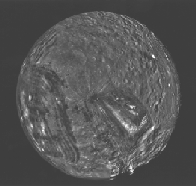 |
| The satellites of Uranus |
The following image (Ref) shows the 5 largest satellites of Uranus: Miranda, Ariel, Umbriel, Titania, and Oberon (here is further discussion about Oberon). There are 10 additional small satellites.
 |
| The satellites of Uranus |

The most interesting moon geologically is Miranda,
shown on the left.
Even
though it is only 500 km in diameter, it shows surface geological features that
are as varied as any site in the Solar System.
It is not clear why Miranda has been
so active geologically. Some theories invoke tidal heating effects earlier in
its history, or a collision that tore it apart and allowed it to coalesce
again. None are very conclusive.